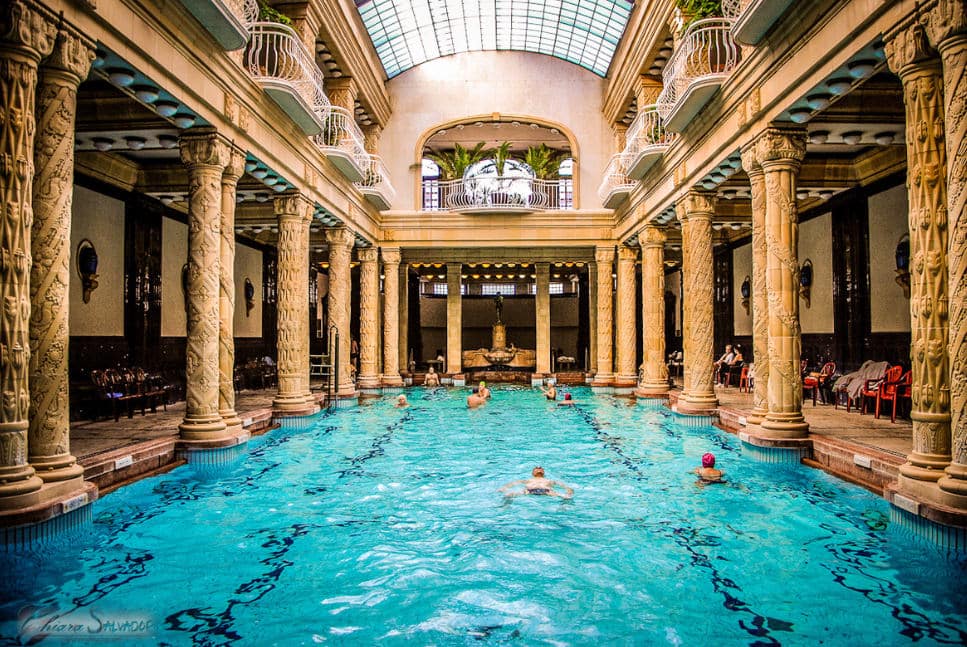

CONTACT US
1052 Budapest, Jane Haining Quay, Dock 11.
Customer support is available daily from 9:00 to 22:00.
Budapest, Jane Haining Quay, Dokk 11, 1052

The Hungarian capital city is quite rich in baths. There are 11 of them in Budapest and you can find both strand and thermal baths among them. Gellért Bath is one of the most famous thermal baths in Budapest. It is not only a bath but also a historical building like Széchenyi Bath, Rudas Bath or Lukács Bath. It is found in the District XI., and the exclusive Gellért Hotel is found in the same building with it. The bath was built in the early 20th century in the style of Art Nouveau.

Gellért Bath exists due to the thermal springs of the Gellért Hill. Even in the medieval ages, people discovered the advantages of its water; some written sources say that Andras King II. founded a bath there in the 13th century for medical purposes. However, the culture of the baths was flourished in the age of Turkish invasion and their bath was called Acsik ilidzse.
The current bath which we can visit nowadays was built between 1912 and 1918 on the base of the plans of Artúr Sebestyén, Ármin Hegedűs, and Izidor Sterk. It represented the style of Art Nouveau and was the most modern bath in contemporary Europe. At that time, a hospital with 30 beds also belonged to the bath. The restaurant of the bath was led by the famous Gundels until 1945 and chefs paid attention to not only the excellent quality but also a healthy diet.
The interior was really exclusive, and the guests of this Budapest thermal bath was so, too. Before the Second World War, it had quite illustrious visitors, such as royal people or talented artists like Yehudi Menuhin. It is an interesting fact that it has closed only once because of the bursting of pipes; this occasion lasted only one day. Unfortunately, during the 2nd world war, some parts of the building were destroyed, but later it was renovated. In the near past, there was another restoration between January 2007 and April 2008. The original style and furnishings such as the Zsolnay mosaics, the marble columns, the colorful glass windows, and statues were all preserved. So the current interior is as imposing as it was in the golden ages of this bath.
There are several decorating items in the building. On the walls, you can adore valuable porcelain which was made in the Zsolnay manufactory. Lots of windows are decorative and colorful; they are created in Miksa Róth’s workshop, on the base of Vince Hende’s plans.
If you visit Gellért Thermal Bath, we recommend paying attention to statues. There are many of them, and all of them are wonderful. Some portray kids during playing or other activities. Miklós Ligeti’s creation which is a little boy with a turtle is really cute. This is one meter high and made of white majolica.

Moreover, you can find some beautiful women statues, for example, a Venus by Adolf Huszár or a Primavera (it means Spring) by János Pásztor. Another statue which portrays a girl with a duck was made in 1894 so before the building of the bath. In the garden, there are also interesting sculptures, such as the “Fight against hydras” by Aladár Gárdos. Hydras are mythic beasts. It is worth seeking the fountains, too; one of them made of Zsolnay porcelain.
Originally, there were separated wings for men and women. At the end of the 1990s, a Polish artist Katarzyna Kozyra masked herself as a man and visited the men’s section. She used hidden cameras and made four short films with the title of “Men’s Bathhouse”; each piece lasted 8 minutes. They were broadcast on the Venice Biennale. However, later these rules became less strict. This system was terminated first at the weekends, but since 1st January in 2013, both wings became coeducational.
The thermal water of the Gellért Bath contains mainly calcium, magnesium, and hydrogen-carbonates ions, but the rate of sodium, sulfate, fluoride, and chloride ions are also high. It can cure diseases of the joints, backbone, or other parts of the skeleton; moreover, it reduces cardiovascular and asthmatic complaints, and chronic bronchitis, too.
The thermal water of some pools are 36°C, so they are warm pools. Actually, thermal water is ‘warm’ between 35 and 37°C. Other ones are 40°C, and they are hot pools.